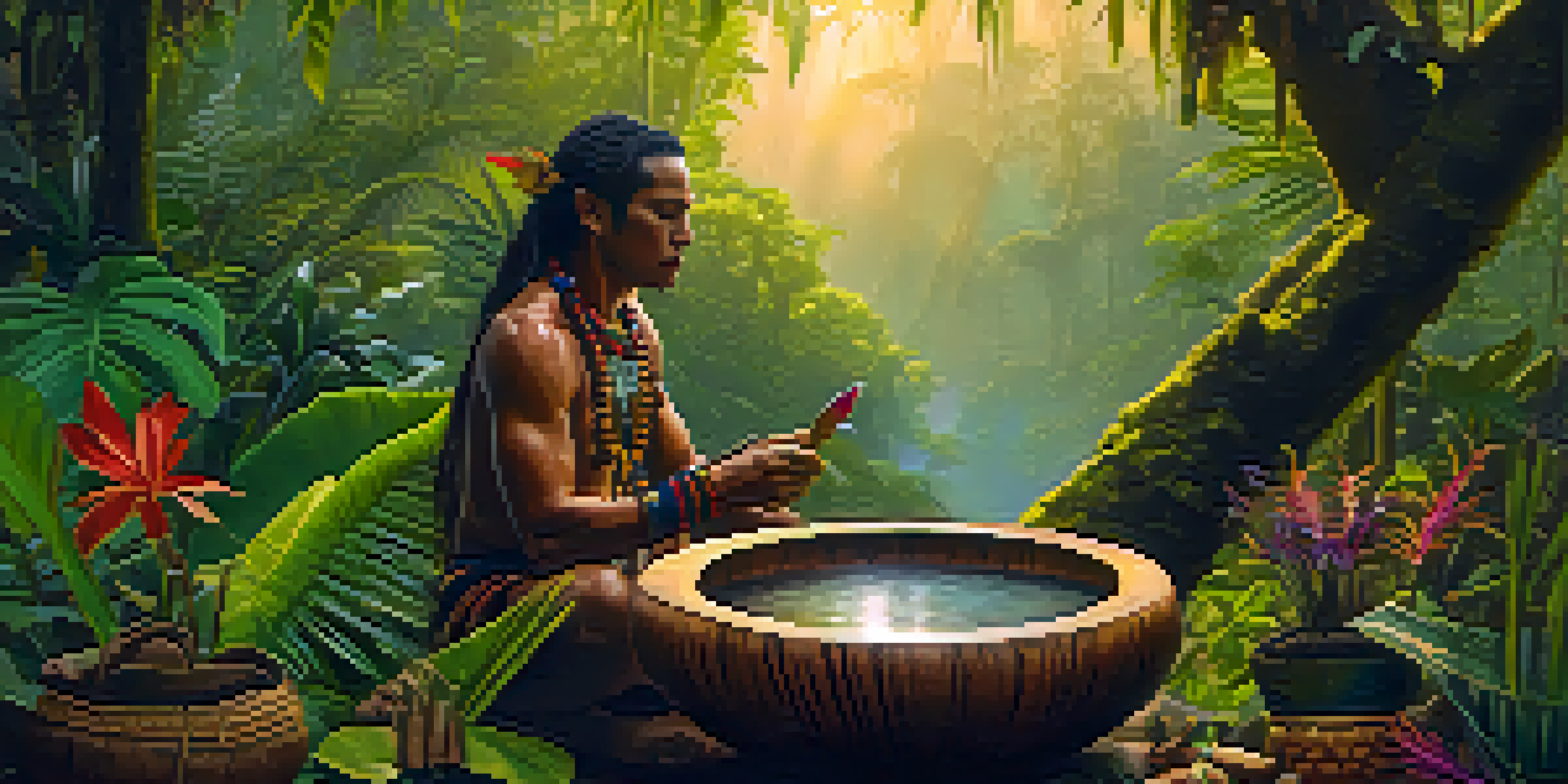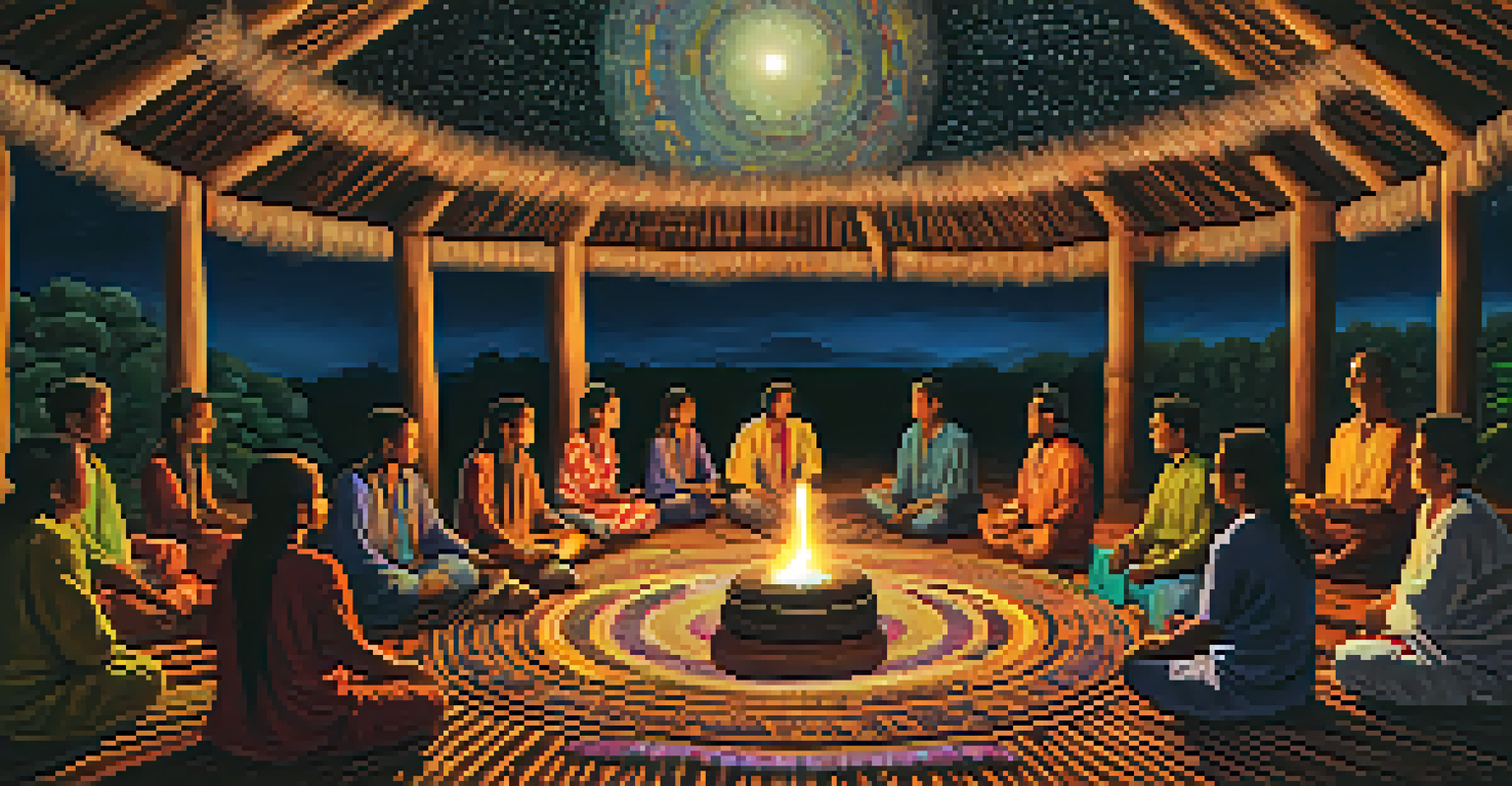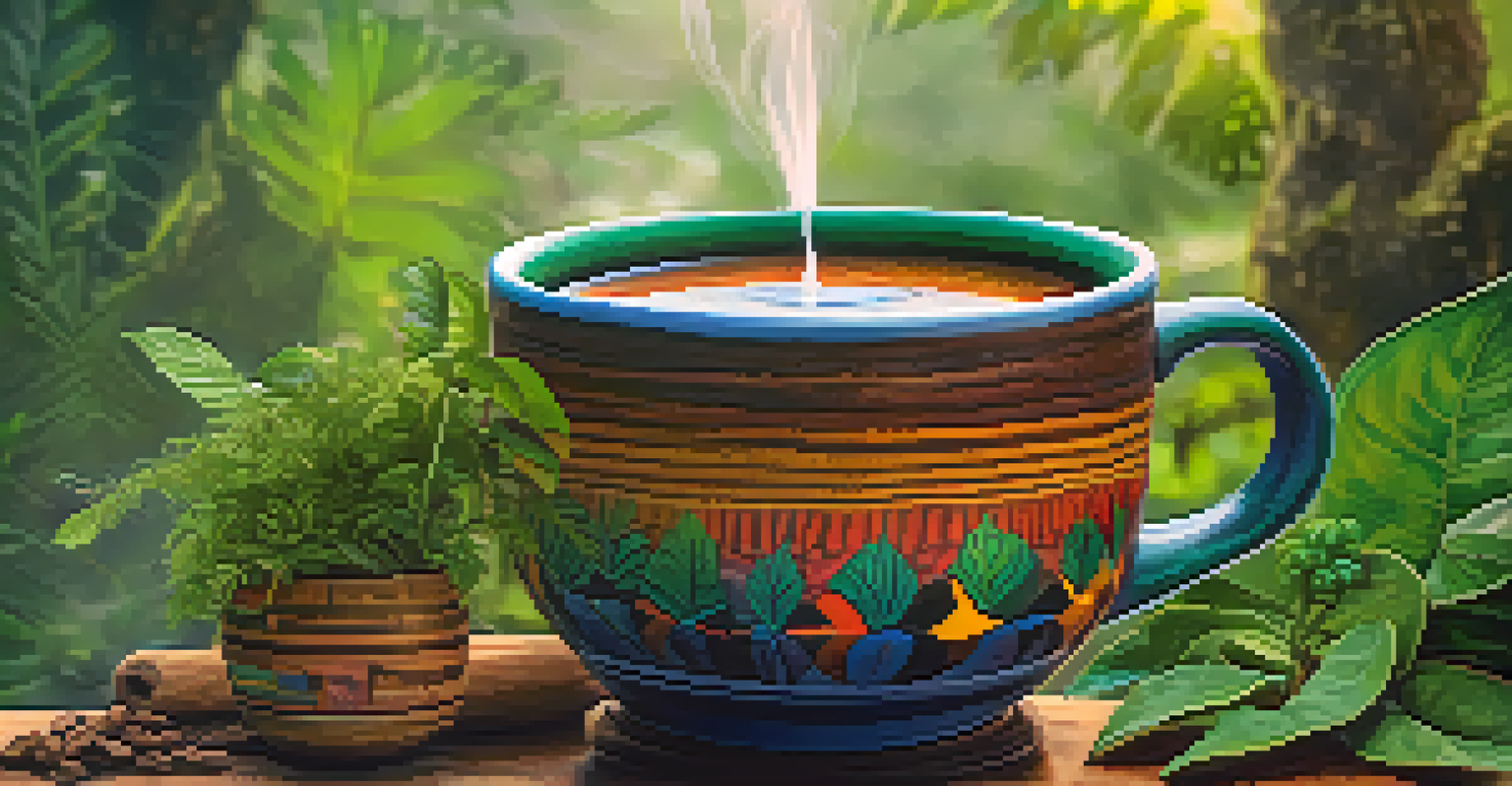Cultural Significance of Ayahuasca in Peruvian Society

Understanding Ayahuasca: A Brief Overview
Ayahuasca is a traditional Amazonian brew made from the Banisteriopsis caapi vine and other plants, primarily used in spiritual ceremonies. Its psychoactive properties, mainly attributed to the compound DMT (dimethyltryptamine), have garnered significant attention worldwide. In Peru, Ayahuasca is not just a drink; it is a powerful cultural artifact that embodies the spiritual beliefs and practices of indigenous communities.
Ayahuasca is not just a drink; it is a powerful cultural artifact that embodies the spiritual beliefs and practices of indigenous communities.
The preparation and consumption of Ayahuasca are often led by a shaman, who guides participants through their journeys. This experience is deeply rooted in the beliefs of interconnectedness with nature and the cosmos. Through these ceremonies, participants often seek healing, self-discovery, and a greater understanding of themselves and their place in the universe.
Ayahuasca's resurgence in popularity outside of Peru has sparked conversations about cultural appropriation and the importance of respecting its origins. Understanding the cultural context of Ayahuasca is essential to appreciating its significance in Peruvian society.
Historical Roots of Ayahuasca in Peru
The use of Ayahuasca dates back thousands of years, with evidence suggesting that indigenous tribes have been utilizing the brew for spiritual and medicinal purposes. The history of Ayahuasca is intertwined with the traditions of the Amazonian peoples, who have revered it as a sacred tool for connecting with the spiritual realm. Oral histories passed down through generations highlight Ayahuasca's role in rituals aimed at healing and divination.

In the pre-colonial era, Ayahuasca was exclusively used by shamans and spiritual leaders. These individuals held a prestigious position within their communities, often acting as healers, advisors, and intermediaries between the physical and spiritual worlds. The rituals surrounding Ayahuasca were not just about the drink itself but involved intricate ceremonies that fostered communal bonds and cultural identity.
Ayahuasca's Cultural Significance
Ayahuasca is a profound spiritual brew that embodies the cultural identity and traditions of indigenous communities in Peru.
With the arrival of European colonizers, the perception of Ayahuasca shifted dramatically. Despite attempts to suppress indigenous practices, Ayahuasca persisted as a symbol of resistance and cultural heritage, continuing to thrive within the communities that embraced it.
The Role of Shamans in Ayahuasca Ceremonies
Shamans play a pivotal role in the Ayahuasca experience, serving as spiritual guides who facilitate healing and insight. Their extensive knowledge of the plants and their properties, combined with their spiritual training, positions them as essential figures in the ceremony. The shaman's role is not only to prepare the brew but also to provide a safe environment for participants as they navigate their inner journeys.
The rituals surrounding Ayahuasca are often seen as a form of cultural expression, showcasing the rich heritage of the Amazonian peoples.
During the ceremony, shamans often use icaros, traditional songs believed to enhance the healing process and connect participants with the spirit world. These songs can evoke powerful emotions and help individuals confront their fears and traumas. The shaman’s ability to read the energy in the room allows them to adjust the ceremony as needed, making their presence vital for a meaningful experience.
The relationship between participants and shamans often extends beyond the ceremony itself, fostering a sense of trust and community. This dynamic is an integral part of the Ayahuasca experience, emphasizing the importance of spiritual guidance in the healing journey.
Ayahuasca and Healing: A Path to Wellness
Many participants turn to Ayahuasca with the hope of healing from psychological and emotional issues. The brew is often associated with powerful experiences that can lead to profound insights and personal breakthroughs. Studies have suggested that Ayahuasca can help alleviate symptoms of depression, anxiety, and PTSD, making it a focal point for those seeking alternative therapeutic methods.
The healing properties of Ayahuasca are attributed not only to its psychoactive effects but also to the ritualistic context in which it is consumed. Participants often report experiencing a sense of release and catharsis during ceremonies, which can facilitate emotional healing. This process is often accompanied by the shaman's guidance, reinforcing the communal aspect of healing.
Role of Shamans in Healing
Shamans serve as vital guides in Ayahuasca ceremonies, facilitating healing and providing a safe space for participants' transformative journeys.
Moreover, Ayahuasca ceremonies emphasize the importance of integration, where participants are encouraged to reflect on their experiences and incorporate insights into their daily lives. This holistic approach to healing highlights the significance of both individual and communal support in the journey towards wellness.
Cultural Identity and Ayahuasca in Peru
Ayahuasca is deeply intertwined with the cultural identity of many indigenous communities in Peru. For these groups, the brew represents not just a spiritual tool but also a means of preserving their traditions and worldviews. The rituals surrounding Ayahuasca are often seen as a form of cultural expression, showcasing the rich heritage of the Amazonian peoples.
The resurgence of interest in Ayahuasca has led to a renewed appreciation for indigenous knowledge and practices. Many Peruvians view this as an opportunity to reclaim their cultural heritage and educate outsiders about the significance of Ayahuasca. This dynamic has sparked a cultural renaissance, fostering pride in indigenous identities and resisting the forces of globalization that threaten these traditions.
However, this cultural revival is not without its challenges. Issues of commercialization and appropriation have emerged, as outsiders seek to profit from Ayahuasca tourism. It is crucial for both locals and visitors to engage in respectful dialogue that honors the cultural roots of Ayahuasca while fostering a sense of mutual understanding.
The Global Spread of Ayahuasca Culture
In recent years, Ayahuasca has gained popularity beyond Peru, attracting seekers from all corners of the globe. This global spread has sparked a fascinating dialogue about the cultural significance of the brew and its implications for indigenous communities. As more people seek out Ayahuasca experiences, the challenge lies in balancing cultural appreciation with respect for its origins.
While many international participants report transformative experiences, the increasing demand for Ayahuasca has raised concerns about the potential exploitation of indigenous traditions. It is essential for visitors to engage with local communities authentically, seeking to understand the cultural context rather than simply seeking a psychedelic experience. This ethical approach helps ensure that the benefits of Ayahuasca remain rooted in its cultural significance.
Challenges of Global Interest
The rising popularity of Ayahuasca outside Peru poses challenges such as commercialization and the need for respectful engagement with indigenous practices.
Ultimately, the global interest in Ayahuasca has the potential to foster cross-cultural connections and promote awareness of indigenous rights. By sharing their stories and experiences, participants can help amplify the voices of the communities that have traditionally held the wisdom of Ayahuasca for generations.
Challenges Facing Ayahuasca Practices Today
Despite its cultural significance, Ayahuasca faces numerous challenges in contemporary society. Issues such as the commercialization of Ayahuasca tourism have led to concerns about the dilution of its traditional practices. Some shamans have reported feeling pressure to cater to tourists rather than focusing on the spiritual aspects of the ceremonies, which can undermine the integrity of the experience.
Furthermore, the increasing popularity of Ayahuasca has raised questions about safety and regulation. While many people have had positive experiences, there are risks involved, particularly for individuals with certain medical conditions. This has led to calls for greater oversight and education to ensure that participants are well-informed before embarking on their Ayahuasca journey.

Additionally, the narrative surrounding Ayahuasca often overlooks the voices of indigenous communities. As interest grows, it is crucial to ensure that these communities are not only respected but also adequately supported in preserving their cultural practices. Addressing these challenges is vital for maintaining the authenticity and integrity of Ayahuasca traditions in Peru.